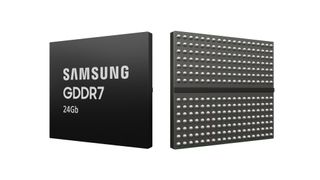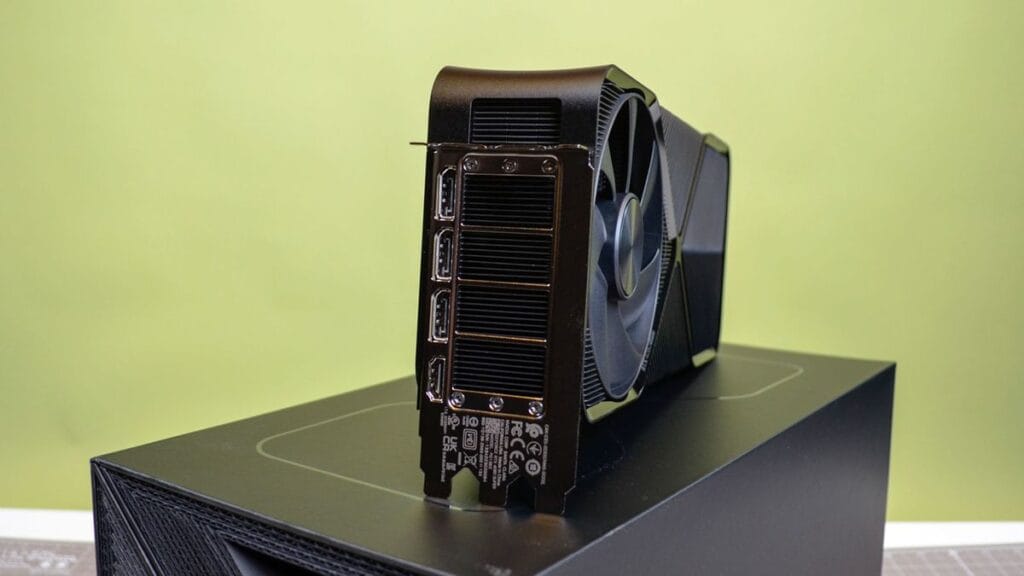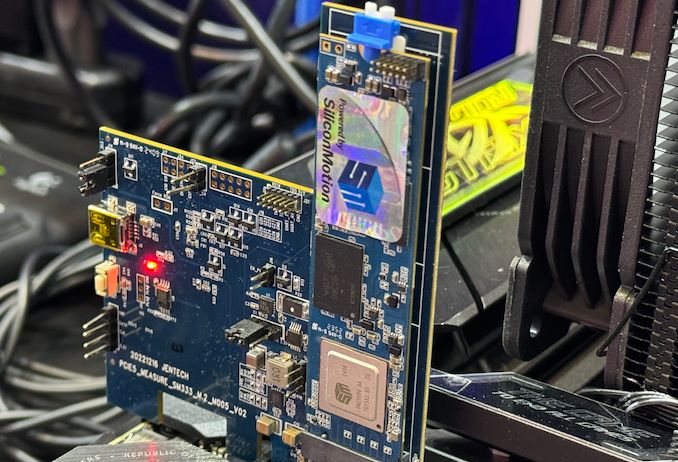Samsung has announced that it’s cooked up some new faster GDDR7 video RAM that might just power up Nvidia’s next-gen Blackwell GPUs at some point next year.
The innovation comes in what Samsung boasts is the industry’s first 24Gb GDDR7 RAM, which builds on its previous 16Gb GDDR7 memory modules (the latter are strongly rumored to be destined for Nvidia’s initial RTX 5000 GPUs).
Samsung notes that the new 24Gb GDDR7 is built on a (5th-generation) 10nm process, and that allows for cell density to be 50% better in the same package size versus its predecessor. With 24Gb VRAM we can have memory modules of 3GB capacity (rather than 2GB modules as with 16Gb GDDR7).
Not only do we get that capacity benefit, but this VRAM is much faster, offering a speed of 40Gbps, we’re told. For context, the GDDR7 memory currently in the works boasts speeds of either 28Gbps or 32Gbps, so this is a leap of 25% on the latter. Samsung also notes that performance could be pepped up to 42.5Gbps in certain use cases, too.
Another noteworthy addition to the list of improvements with GDDR7 is better power-efficiency to the tune of 30%.
Samsung tells us that validation (testing and sampling) for this new RAM will begin later in 2024, and it’ll be deployed commercially early in 2025.

(Image credit: Samsung)
Analysis: A step forward for Samsung – and next-gen Nvidia Super (or Ti) GPUs too?
While 24Gb GDDR7 is expected to be a major boon for heavyweight applications (AI, data centers and so forth), it will also likely find a home in consumer graphics cards – at least to some extent.
{ window.reliablePageLoad.then(() => { var componentContainer = document.querySelector(“#slice-container-newsletterForm-articleInbodyContent-Cb8QmHxSdXxqXV9HtduVnm”); if (componentContainer) { var data = {“layout”:”inbodyContent”,”header”:”Get daily insight, inspiration and deals in your inbox”,”tagline”:”Sign up for breaking news, reviews, opinion, top tech deals, and more.”,”formFooterText”:”By submitting your information you agree to the Terms & Conditions and Privacy Policy and are aged 16 or over.”,”successMessage”:{“body”:”Thank you for signing up. You will receive a confirmation email shortly.”},”failureMessage”:”There was a problem. Please refresh the page and try again.”,”method”:”POST”,”inputs”:[{“type”:”hidden”,”name”:”NAME”},{“type”:”email”,”name”:”MAIL”,”placeholder”:”Your Email Address”,”required”:true},{“type”:”hidden”,”name”:”NEWSLETTER_CODE”,”value”:”XTR-D”},{“type”:”hidden”,”name”:”LANG”,”value”:”EN”},{“type”:”hidden”,”name”:”SOURCE”,”value”:”60″},{“type”:”hidden”,”name”:”COUNTRY”},{“type”:”checkbox”,”name”:”CONTACT_OTHER_BRANDS”,”label”:{“text”:”Contact me with news and offers from other Future brands”}},{“type”:”checkbox”,”name”:”CONTACT_PARTNERS”,”label”:{“text”:”Receive email from us on behalf of our trusted partners or sponsors”}},{“type”:”submit”,”value”:”Sign me up”,”required”:true}],”endpoint”:”https://newsletter-subscribe.futureplc.com/v2/submission/submit”,”analytics”:[{“analyticsType”:”widgetViewed”}],”ariaLabels”:{}}; var triggerHydrate = function() { window.sliceComponents.newsletterForm.hydrate(data, componentContainer); } if (window.lazyObserveElement) { window.lazyObserveElement(componentContainer, triggerHydrate); } else { triggerHydrate(); } } }).catch(err => console.error(‘%c FTE ‘,’background: #9306F9; color: #ffffff’,’Hydration Script has failed for newsletterForm-articleInbodyContent-Cb8QmHxSdXxqXV9HtduVnm Slice’, err)); }).catch(err => console.error(‘%c FTE ‘,’background: #9306F9; color: #ffffff’,’Externals script failed to load’, err)); ]]>
Sign up for breaking news, reviews, opinion, top tech deals, and more.
While all this remains speculation, Nvidia is expected to use 28Gbps (and 32Gbps) GDDR7 in its next-gen Blackwell graphics cards, leaving the possibility that Team Green may adopt this supercharged 40Gbps VRAM at some point. For an RTX 5090 Ti, perhaps? It’d obviously have to be a high-end graphics card, though we guess another possibility is an RTX 5080 Ti or Super (perhaps the rumored 24GB of VRAM spin on the 5080 – given the 3GB module capacity, as mentioned).
What about AMD or Intel using GDDR7? Rumors around AMD’s RDNA 4 GPUs insist that Team Red won’t be making the leap to GDDR7, and instead will stick with current GDDR6, which makes sense given that the next-gen RX 8000 graphics cards are supposedly topping out at the mid-range. AMD will want to make them competitive in this space, no doubt, and steering away from cutting-edge VRAM seems like a plan in terms of keeping costs down, if this is the overall idea.
As for Intel, 2nd-gen Arc Battlemage graphics cards are rumored to be low-end only, so clearly GDDR7 won’t be on the table for those GPUs. It seems only Nvidia is jumping on the next-gen VRAM bandwagon next year, although even that remains a rumor – and we don’t know if Team Green will push as hard as deploying this faster 40Gbps memory in its Blackwell GPUs in 2025 (but we can hope).
Via Wccftech




